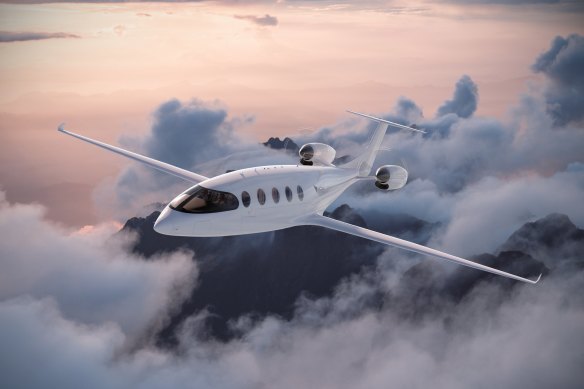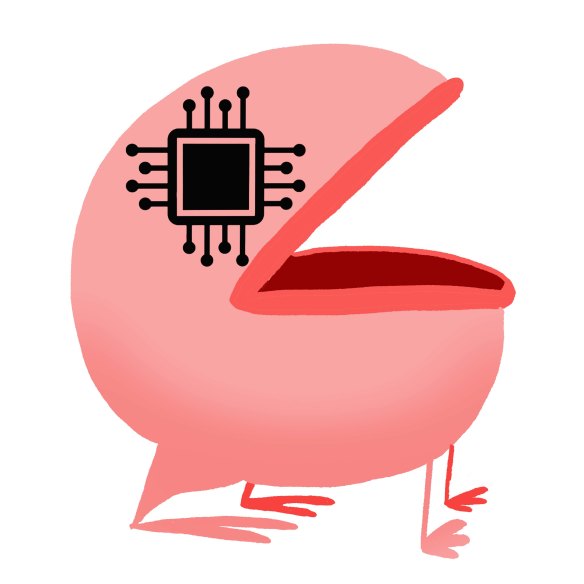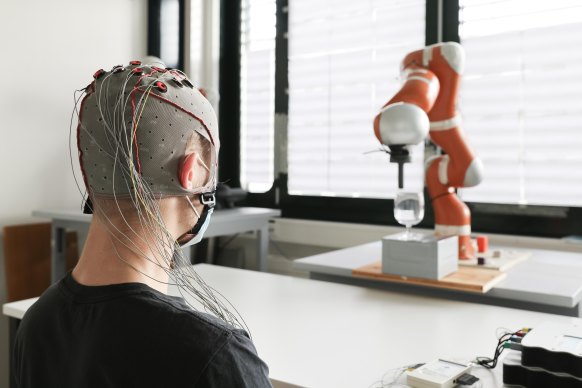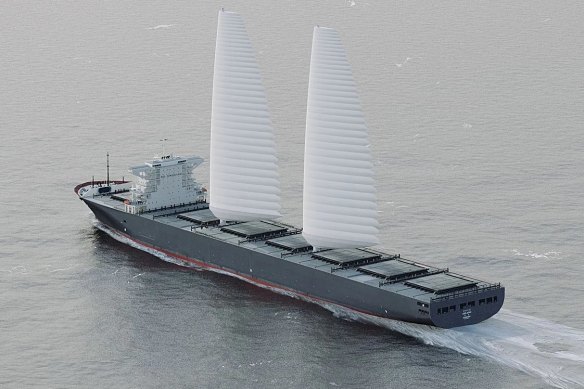This was published 2 years ago
From Pac-Man-like ‘living machines’ to mind-control devices: Freaky and fab new tech
From biodegradable cling-wrap to microscopic robots made of stem cells: the next inventions that could change the way we live.
By Tony Davis
1. Pop(corn) the question

Scientists have developed building insulation using popcorn.Credit: Simon Letch
High-tech does not have to involve nanotechnology or robotics. There is something beautiful in finding everyday, natural materials that can replace plastics, for example. Great Wrap in Victoria is selling a biopolymer resin cling-wrap based on potato waste. It breaks down into carbon and water within six months in a compost pile, cutting back on the 150,000 tonnes of the plastic variety that goes into Australian landfill each year.
Scientists at Germany’s Göttingen University have developed a plant-based building insulation from – wait for it – popcorn. When treated, granulated popcorn reportedly offers excellent thermal insulation and fire resistance, providing a sustainable alternative to petroleum-based products.
And in South Australia, 3RT next year will commission a new robotic factory that will use a patented laminating process to turn low-cost plantation timber into commercial quantities of what it calls Designer Hardwood, with similar properties and appearance to 100-year-old hardwood.
MD Peter Torreele explains the main advantage, aside from cost: “You don’t have to log any more of those mature trees. We have an ongoing unlimited supply and … much less waste.” 3RT can use 75 per cent of the log, compared to the 32 per cent of a traditional hardwood sawmill.
2. Power trip

Electric-powered passenger planes are on the horizon. Credit: Simon Letch
The drone-like “flying cars” have received all the attention, but electric-powered passenger planes are also on the horizon. We won’t be heading off to Europe on batteries anytime soon, but we could be making regional short hops this decade.
Israel’s Eviation is one of many companies vying for a piece of the action. Although competing with Boeing, Rolls-Royce and Airbus, Eviation has a head start with its Alice prototype, which is fully electric rather than hybrid.
The dual motor, T-tail plane with a lightweight composite body seats nine passengers and two crew. Unladen, it can fly about 800 kilometres between charges, and cruise at 460 kilometres an hour. With passengers and luggage that should fuel about one hour’s flying time, enough to cover thousands of routes around the world.

Israel’s Eviation has developed a fully electric prototype called Alice.
Cape Air, a large US regional carrier, has ordered 75 Alices (subject to conditions). “There’ll be a huge transition to smaller electric aircraft in the near future,” says Korum Ellis, the founder of FlyOne, a Perth company that has imported our first e-plane, the two-seater Pipistrel. “It’s an absolute no-brainer. The cost of an electric aircraft is similar to a combustion-engine counterpart, but the cost of maintenance is maybe one-10th. The only barrier anyone has is range at the moment, but that will slowly dissolve through time just as with the early EVs.”
3. Come in, spinner

Scientists may have discovered a way to deploy satellites without using vertical thrust.Credit: Simon Letch
It’s not rocket science. Since 2014, the people at SpinLaunch have been investigating how to deploy satellites using centrifugal energy rather than vertical thrust. They believe their high-tech slingshot – a capsule containing one or two satellites flung into space – can lower costs, reduce carbon emissions and greatly increase the number of satellites weighing up to 200 kilograms that can be deployed.
The California-based company has successfully launched a variety of test vehicles at supersonic speeds at its New Mexico facility.

California-based SpinLaunch has been investigating how to deploy satellites using centrifugal energy rather than vertical thrust.
With the market for small satellites serving everything from weather monitoring to military applications rapidly increasing – one estimate sees it doubling between 2021 and 2026 – SpinLaunch believes it is providing something different to conventional launching sites. Its A-33 kinetic system uses a 33-metre-wide mass accelerator that spins at up to 8000 kilometres an hour.
Once the satellites are in orbit, small, low-cost rockets will position them. However, the company isn’t going to be putting people into space. Even the existing mass accelerator generates 10,000 times the force of gravity, something no astronaut could survive. If things go to plan, a NASA dummy
payload will be sent up this year, with the first satellites hurled into the heavens in 2025.
4. Hip Hoppers

Xenobots are claimed to be the world’s first living machines.Credit: Simon Letch
They’re nothing much to look at (though to one xenobot, another xenobot might be beautiful), but they are claimed to be the world’s first living machines. These microscopic robots, not even one millimetre wide, were made using stem cells from the embryos of African clawed frogs (Xenopus
laevis), from which they took their name.

Researchers combined skin and heart cells to make self-replicating machines.
Researchers used artificial intelligence to discover how to combine different cell types from the embryos to meet their needs.
“In our first paper,” says co-developer Joshua Bongard, a computer scientist and robotics expert at the University of Vermont, the artificial intelligence figured out “how to combine skin and heart cells [which act as small motors] to make a walking xenobot. In our third paper, we showed that it could combine just skin cells into a Pac-Man shape that allowed xenobots to create copies of themselves.”
The team isn’t sure how this new tech will be used. “They are biocompatible and biodegradable machines that could, in theory, work alongside other living systems,” says Bongard. “They could collect micro-plastics out of waterways, contaminants out of soils, inspect the root systems of plants in vertical farms, or help construct plant-based meat.” Pessimists fear that these self-replicating machines could take over the world, turning everything into “grey goo”.
5. Mind Control

Mind control may be one step – or thought – closer to reality.Credit: Simon Letch
We’ve heard of it and seen it in B-grade films, but it’s really happening. Researchers at Swiss Federal Institute of Technology in Lausanne have brought mind control one step – no, one thought – closer.

A prototype mind control device.
They have devised a robotic arm and a machine-learning program that’s connected to a human brain via a head cap fitted with electrodes to scan brain activity. No voice control or touch is required, with thought alone enough to move the arm, according to their research.
If the robot makes an incorrect move, the patient’s brain will produce an error message which is fed into the controlling algorithm. Trial and error – such as moving the arm closer to the object, then further away – eventually teaches the robot the required action via an “inverse reinforcement learning approach”.
It’s hoped that it will allow tetra-plegic people to regain some of their lost dexterity and, eventually, be used to control a wheelchair.
6. Sail of the Century

The WISAMO project is said to cut fuel use by up to 20 per cent.Credit: Simon Letch
Later this year, the French merchant ship MN Pelican will travel twice a week between Spain and Great Britain, testing an old maritime technology made new again that could slash carbon emissions. The WISAMO Project – a contraction of Wing Sail Mobility – is an inflatable, “intelligent” sail being developed by Michelin, the French company best known for tyres and restaurant ratings, and two Swiss inventors. Fittingly, the sail looks rather like the Michelin man.
Maritime emissions, already at 3 per cent of global totals, are rising. MN Pelican will hoist only a single 100-square-metre wing but, as trials progress, it’s hoped that larger and, perhaps, multiple sails will be added. It self-rigs at the touch of a button, is automated to catch the best available wind and retractable for easier access to ports. Michelin says WISAMO can cut fuel use by up to 20 per cent, and is suitable for many vessels.

The WISAMO Project – an inflatable, “intelligent” sail being developed by Michelin
Other companies are working on rigid or flexible sails of different materials. The UK’s Bar Technologies is concentrating on adding wind power to bulk carriers and tankers, and believes a row of three or four of its 47-metre-tall steel WindWings could reduce fuel use by up to 30 per cent. Sweden’s Oceanbird car carrier is more ambitious again, aiming to run solely on wind with no fossil fuel assistance.
Its maiden voyage is planned for 2026. Other companies, including the delightfully named Finnish company Norsepower, are looking at adding kites, spinning tubes and rotor sails to help decarbonise the ocean waves.
7. It Takes Two

Researchers are tackling the complex task of creating a human digital twin.Credit: Simon Letch
The digital twin is already used in business. It’s the software replication of a physical system, building or machine which allows testing, experimentation and modifications before production of the real thing. But what if it could be done for humans? What if your digital twin could be used to test different diets, treatments and medicines?
Constructing a human digital twin is unimaginably complex. Still, the first steps are being taken. Virtual reality is being used to plan complex operations, such as the separating of conjoined twins. US company Q Bio claims its radiation-free, MRI scanner can measure hundreds of biomarkers,
from hormone levels to liver fat to “cancer tumour markers”. It produces a 3D digital avatar of a patient’s body for $5000, producing what it calls “the physical of the future”.
Steven M. Levine, senior director of virtual human modelling at Dassault Systèmes, writes that a digital twin could eventually replace animal testing and reduce human trials, “providing, in parallel, a living, breathing medical record that combines the latest fundamental knowledge with the patient’s exact history and unique physiology”. That day is still way in the future, though.
To read more from Good Weekend magazine, visit our page at The Sydney Morning Herald, The Age and Brisbane Times.